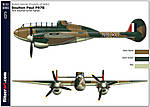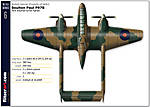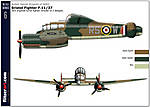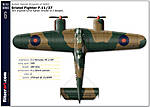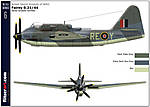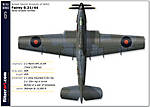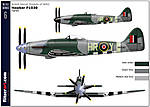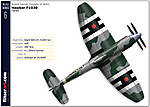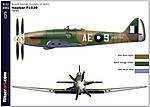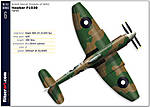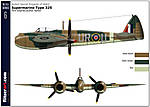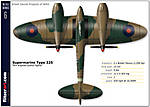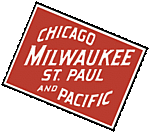1⁄35British Secret Projects of WW2. Vol 2
15
Comments
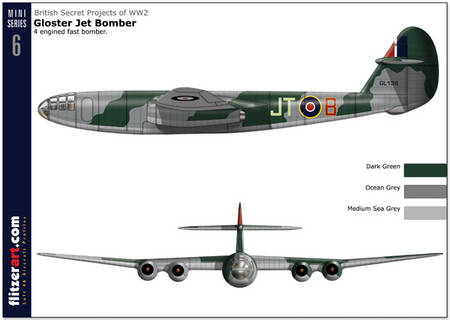
Continuing on from the first volume for British WW2 Secret Projects, again the greatest of thanks go to Rowan (Merlin) for being the info-master and ace supplier of refs. In fact I view these newer profile sets as a joint effort as Rowanís invaluable input makes doing them a whole lot easier.
For this set Iíve tried to add a few more colour scheme variations. So without further ado.
Bristol F.11/37
Iíve profiled here one of two designs for Bristolís two seat, twin engined turret fighter concept. The design flares the cockpit/fuselage into the joined leading edge of the main wings. The other concept was very similar but somewhat bigger.
Fairey
A three seat, twin engined turret naval fighter design with the 2 engines housed in the forward fuselage powering a single contra-prop. The furthest forward engine being in the nose under the cockpit floor while the second engine is mounted higher directly behind the cockpit.
Gloster Jet Bomber
Although much bigger this design reminds me of the Arado Ar234, especially the four engined ĎCí version. The Arado had a wing span of 46 ft 4 ins and a length was 41 ft 6 ins against the Glosterís 84 ft wing span and 65ft 6 ins length. The Gloster was penned on12/8/41, a little later than the Arado. A case of great minds think alike?
Hawker P1030
Looking like a larger version of the earlier P1027 design which was a development of the Tempest, the P1030 was designed to incorporate the Eagle engine concept and featured the radiators housed in the leading edge of the inner wing section.
Supermarine Type 325
Essentially the same concept as the type 324 concept, the type 325 explored a twin engined pusher layout based on Merlin engines or as illustrated here a pair of Bristol Taurus units.
Supermarine Type 391
The Type 391 was another design to utilise the Eagle engine concept, but was penned later than the Hawker P1030. The Type 391 utilised the laminar flow wing from the Spiteful/Seafang.
Many thanks. Until next time...
For this set Iíve tried to add a few more colour scheme variations. So without further ado.
The Aircraft
Boulton Paul P97B A three seat, twin engined turret fighter design featuring a twin boom layout.Bristol F.11/37
Iíve profiled here one of two designs for Bristolís two seat, twin engined turret fighter concept. The design flares the cockpit/fuselage into the joined leading edge of the main wings. The other concept was very similar but somewhat bigger.
Fairey
A three seat, twin engined turret naval fighter design with the 2 engines housed in the forward fuselage powering a single contra-prop. The furthest forward engine being in the nose under the cockpit floor while the second engine is mounted higher directly behind the cockpit.
Gloster Jet Bomber
Although much bigger this design reminds me of the Arado Ar234, especially the four engined ĎCí version. The Arado had a wing span of 46 ft 4 ins and a length was 41 ft 6 ins against the Glosterís 84 ft wing span and 65ft 6 ins length. The Gloster was penned on12/8/41, a little later than the Arado. A case of great minds think alike?
Hawker P1030
Looking like a larger version of the earlier P1027 design which was a development of the Tempest, the P1030 was designed to incorporate the Eagle engine concept and featured the radiators housed in the leading edge of the inner wing section.
Supermarine Type 325
Essentially the same concept as the type 324 concept, the type 325 explored a twin engined pusher layout based on Merlin engines or as illustrated here a pair of Bristol Taurus units.
Supermarine Type 391
The Type 391 was another design to utilise the Eagle engine concept, but was penned later than the Hawker P1030. The Type 391 utilised the laminar flow wing from the Spiteful/Seafang.
Many thanks. Until next time...
Comments
Many thanks for your kind comments.
Ross
Unfortuneately there are no kits currently available...
But Sharkit are planning to do a few British Secret Projects in the not to distant future but not any illustrated here as far as I'm aware.
They have asked for ideas of what people might like, so you could always send a list...
Cheers
Peter
:-)
JAN 09, 2007 - 11:35 AM
Antoni,
you are quite right they do look similar and also to the P99.
Must have been a popular BP layout.
I think the P92 was later; post war.
I'll check my refs tonight.
Cheers
Peter
:-)
JAN 09, 2007 - 11:40 AM
Let's start a discussion here then and send them a list. How many suggestions are they looking for? Awesome as always Peter!
JAN 09, 2007 - 11:42 AM
The type 97 I havenít come across before but 92 precedes 97 so the type 92 must have been earlier. In fact it originated before WW II. There is nothing I can add to the details (and photograph) on this site: LINK
So no need for me to repeat them here.
The type 92ís turret was fitted with a 40mm Vickers S cannon and installed in the prototype Wellington Mk II L4250. Later the gun was remounted in a larger, streamlined turret that caused the geodetic structure to flex. The fabric in the area of the turret was replaced with stressed-skin metal. The directional stability of the Wellington was affected by the turret so twin fins and rudders were fitted.
 The concept used in the Gannet, twin engines driving a contra-rotating propeller, also dated back before WW II. Fairey Battle K9370 was used to test their P.24 Monarch engine (2 coupled Prince P.12s). Four speed, two-stage supercharged and liquid-cooled it had independently controlled and synchronised counter-rotating and feathering co-axial propeller drives. K9370 made its maiden flight in June 1939.
The concept used in the Gannet, twin engines driving a contra-rotating propeller, also dated back before WW II. Fairey Battle K9370 was used to test their P.24 Monarch engine (2 coupled Prince P.12s). Four speed, two-stage supercharged and liquid-cooled it had independently controlled and synchronised counter-rotating and feathering co-axial propeller drives. K9370 made its maiden flight in June 1939.
 Details of the Monarch reached the US and they were interested in it as a potential power-plant for the P-47. As few Monarchs had been assembled, K9370, with its engine, was sent to the USA. The roundels were removed and stars painted on the wings and red and white stripes on the rudder.
Details of the Monarch reached the US and they were interested in it as a potential power-plant for the P-47. As few Monarchs had been assembled, K9370, with its engine, was sent to the USA. The roundels were removed and stars painted on the wings and red and white stripes on the rudder.
 In 1943 it returned to the RAE. All work by Faireyís powerplant department was ended by the Ministry of Aircraft Production in 1943 as they thought too much effort was being expended on too many engine designs within the industry. If the P.24 had ever given its proposed 2,240hp the Battle would have had a speed of 365mph!
In 1943 it returned to the RAE. All work by Faireyís powerplant department was ended by the Ministry of Aircraft Production in 1943 as they thought too much effort was being expended on too many engine designs within the industry. If the P.24 had ever given its proposed 2,240hp the Battle would have had a speed of 365mph!
JAN 09, 2007 - 08:23 PM
Hi Antoni
again you are right re: P92.
I was thinking of the P122. This was also a twin boom design from Boulton Paul to Air Ministry Spec F124T dated 1952. The design called for rocket power.
Intresting stuff.
Cheers
Peter
:-)
JAN 10, 2007 - 11:40 AM
That is one mean looking Battle! The original looked too dainty, somehow.
Another B P design proposal was to convert the Defiant to a single-seat fighter with a battery of 8 forward firing .303 Brownings...
 It was flown, albeit unarmed, acheiving a respectable 362 Mph. And it would be a simple kit conversion.
It was flown, albeit unarmed, acheiving a respectable 362 Mph. And it would be a simple kit conversion.
 It was flown, albeit unarmed, acheiving a respectable 362 Mph. And it would be a simple kit conversion.
It was flown, albeit unarmed, acheiving a respectable 362 Mph. And it would be a simple kit conversion.JAN 13, 2007 - 03:33 PM
Copyright ©2021 by Peter Allen. Images also by copyright holder unless otherwise noted. The views and opinions expressed herein are solely the views and opinions of the authors and/or contributors to this Web site and do not necessarily represent the views and/or opinions of AeroScale, KitMaker Network, or Silver Star Enterrpises. Images also by copyright holder unless otherwise noted. Opinions expressed are those of the author(s) and not necessarily those of AeroScale. All rights reserved. Originally published on: 2007-01-07 00:00:00. Unique Reads: 36805




